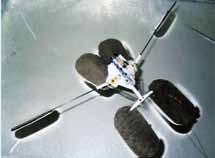Chinese researchers have developed a microbot that can repeatedly jump across the surface of water without tanking. The researchers team from School of Chemical Engineering and Technology was led by Prof. Qinmin Pan. They used a porous, highly repellent nickel foam coating so that the strider-like bot’s legs are able to stay afloat with every 14cm leap it makes, despite it weighing as much as 1100 water striders.

scientificearthconscientious6.files.wordpress.com)
Scientists have reported a number of advances toward tiny robots that can walk on water. Such robots could skim across lakes and other bodies of water to monitor water quality or act as tiny spies.
However, even the most advanced designs—including one from Pan’s team last year—can only walk on water. Real aquatic striders actually leap, notes Pan. It’s difficult to make a jumping robot because the downward force needed to propel it into the air usually pushes the legs through the water’s surface. To overcome the challenge, Pan’s group used nickel foam coating to build a true water-striding robot.
Flexible batteries promise ‘foldable’ electronics
You have already heard about flexible displays, printed circuits, memory and even chargers. Scientists have now created a flexible battery that can be folded, bent and distorted in a host of different ways. These batteries promise thinner and lighter smartphones, tablets and e-book readers that could be flexible and hold more capacity. You could roll up these devices for easy storage in your pocket.
A team of researchers at the Korean Advanced Institute of Science and Technology (KAIST) is behind the new flexible solidstate battery. This rechargeable lithium-ion battery (LIB) retains its energy level even when folded, spindled or mildly mutilated. It is actually printed on a thin film. Applying battery material to rollable displays has been a major cause for concern for gadget manufacturers thus far. This breakthrough is likely to change the way we think about surfaces and screens.
The research team is currently investigating a laser lift-off technology to facilitate the mass production of flexible batteries and 3D stacking structures to enhance charge density of batteries.
Microchips to replace humans in drug testing
There have been debates about testing drugs on animals or any other living creature. Well, here comes a solution that will put the problem to an end. Scientists from Harvard University and Defense Advanced Research Projects Agency (DARPA) of USA have developed a microchip that can now be used for such tests. This microchip is a small translucent device, which can be used as a human organ for testing drugs.
According to reports, this single device can bring together ten organ-chips in order to enable study of the effect of a particular drug on the whole body. Every organ on this microchip is made using clear flexible polymer. It also consists of hollow microfluid channels that are lined by living human cells. It is these human cells that allow scientists to study the impact of any drug on human organs. Since the device is translucent, it allows researchers to easily view the response of the organs to a drug.
Harvard University has successfully designed microchips that mimic lung, heart and intestine.
Digital iris that fools biometric scanners
At the recently held Black Hat Security Conference by academics in Spain and the US, a new technique of recreating iris images using the digital codes that are stored in databases and used by iris-recognition systems to identify people was shown. Interestingly, the replica images could even trick the commercially graded iris-recognition systems.
“The idea is to generate the iris image, and once you have the image you can actually print it and show it to the recognition system, and it will say ‘okay, this is the (right) guy,’” says Javier Galbally, who conducted the research with colleagues at the Biometric Recognition Group-ATVS, at the Universidad Autonoma de Madrid, and researchers at West Virginia University.
Earlier, researchers could create wholly synthetic iris images with the characteristics of real iris images. Though the images fooled iris-recognition systems into thinking they were real irises, they were not quite useful in impersonating a real person.
“But this is the first time anyone has essentially reverse-engineered iris codes to create iris images that closely match the eye images of real subjects, creating the possibility of stealing someone’s identity through their iris,” mentions a report by Threat Level.
Transparent solar cell
University of California, Los Angeles (UCLA) researchers have developed a see-through solar cell for windows that generate electricity. According to the researchers, it is an advance toward giving windows in homes and other buildings the ability to generate electricity while still allowing people to see outside. In other words, these transparent solar cells could one day be used to build solar windows or even sun collecting smartphones.









